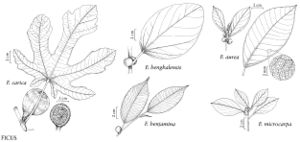Ficus
Sp. Pl. 2: 1059. 175.
Gen. Pl. ed. 5, 482. 1754.
| Taxon | Illustrator ⠉ | |
|---|---|---|
 | Ficus benjamina Ficus microcarpa Ficus benghalensis Ficus carica Ficus aurea | John Myers John Myers John Myers John Myers John Myers |
Trees, shrubs, or woody vines, evergreen or deciduous, commonly epiphytic or scandent as seedlings; sap milky. Terminal buds surrounded by pair of stipules. Leaves alternate, monomorphic (dimorphic in F. pumila); stipules caducous, fused, enclosing naked buds. Leaf-blade: margins entire (lobed in F. carica), rarely dentate; venation pinnate or nearly palmate. Inflorescences small, borne on inner walls of fruitlike and fleshy receptacle (syconium). Flowers: staminate and pistillate on same plant. Staminate flowers sessile or pedicellate; calyx of 2-6 sepals; stamens 1-2, straight. Pistillate flowers sessile; ovary 1-locular; style unbranched, lateral. Syconia globose to pyriform; achenes completely embedded in enlarged, fleshy, common receptacle and accessible by apical opening (ostiole) closed by small scales. x = 13.
Distribution
Tropics and subtropics, chiefly Asian
Discussion
Species ca. 750 (10 in the flora).
Worldwide, Ficus is one of the largest genera of flowering plants. Members of the genus are usually treated as a separate tribe within Moraceae because of their unique inflorescence and wasp-dependent system of pollination.
The floral characters (especially of the American species, which are quite uniform) are exceedingly difficult to use or of little value in distinguishing species. Therefore they are not used in the species descriptions. The form of the syconium, however, is often significant and taxonomically useful.
Ficus pseudocarica Miquel was cited by P. A. Munz (1974) as an occasional escape in the Santa Barbara region. It is not cited by other workers, and I have seen no specimens.
Ficus rubiginosa Desfontaines ex Ventenat cultivar `Florida', a species native to Australia, has recently been reported as naturalized in the Los Angeles area (Michael O'Brien, pers. comm.). It is a small tree with rusty-pubescent branchlets, petiole, and abaxial leaf surfaces; ovate to elliptic-oblong, leathery, 10-cm leaves; and paired axillary, globose, warty, rusty-pubescent syconia 1 cm in diameter. Vernacular names include Port Jackson fig, rusty fig, and littleleaf fig.
Selected References
None.
Lower Taxa
Key
| 1 | Plants climbing, attaching by nodal adventitious roots, or trailing; leaves dimorphic. | Ficus pumila |
| 1 | Plants erect or essentially so; leaves monomorphic. | > 2 |
| 2 | Leaf blade palmately 3–5-lobed, pubescent. | Ficus carica |
| 2 | Leaf blade entire, glabrous (abaxially puberulent in F. benghalensis). | > 3 |
| 3 | Apex of leaf blade abruptly long-caudate or long-acuminate, ca. 1/2 length of blade. | Ficus religiosa |
| 3 | Apex of leaf blade obtuse to acute or if caudate, then much shorter in proportion to blade. | > 4 |
| 4 | Basal leaf veins (2–)3–4 pairs; fruit pubescent. | Ficus benghalensis |
| 4 | Basal leaf veins 1(–2) pairs; fruit glabrous. | > 5 |
| 5 | Leaf blade with more than 10 uniform lateral veins, these regularly spaced. | > 6 |
| 5 | Leaf blade with fewer than 10 lateral veins, or if more than 10, these not uniformly spaced. | > 7 |
| 6 | Leaf blade 4–6(–11) cm; stipules 0.8–1.2 cm; syconia nearly globose. | Ficus benjamina |
| 6 | Leaf blade 9–30 cm; stipules 3–10 cm; syconia oblong-ovoid. | Ficus elastica |
| 7 | Syconia on peduncles (2–)5–10(–15) mm. | > 8 |
| 7 | Syconia sessile or subsessile, rarely with peduncles to 5 mm. | > 9 |
| 8 | Petiole (0.7–)1.5–6 cm; syconia spotted; base of leaf blade usually cordate or rounded to obtuse. | Ficus citrifolia |
| 8 | Petiole 0.2–1 cm; syconia not spotted; base of leaf blade usually acute or cuneate to obtuse. | Ficus americana |
| 9 | Leaf blade 6–12(–15) cm; syconia 6–15 mm diam. | Ficus aurea |
| 9 | Leaf blade 3–11 cm; syconia 5–6 mm diam. | Ficus microcarpa |